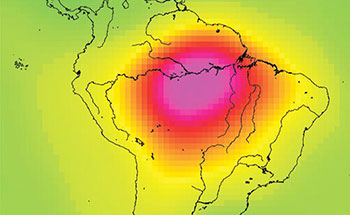Tracking groundwater changes around the world
There was a time when the world’s greatest cities were located on the banks of rivers. Water stored beneath the earth’s surface is a resource that has made life viable in many dry places across the planet. Groundwater consumption has become a critical element of urban development and the expansion of human populations into regions that would be otherwise uninhabitable. Much of the world’s groundwater reserves come from “fossil” aquifers. That means that water last replenished the aquifer a very long time ago: in the range of 10,000-20,000 years, when our planet was in its last glacial period. In many cases, if we use this water today, it won’t be recharged during our lifetimes. So there is a finite amount of water for use presently, and excessive withdrawal becomes unsustainable.

Unfortunately, groundwater use is difficult to monitor globally. Even in the U.S., wells that are drilled on private property can be exempt from official monitoring. This is a somewhat illogical concept, as aquifers themselves (the underground basins that hold groundwater reserves) often exceed the boundaries of private property, and the water in them flows freely between the land of several property owners. As water is a shared resource, it should be managed with common benefits and conservation in mind.
NASA’s GRACE mission provides the first opportunity to directly measure groundwater changes from space. By observing changes in the Earth’s gravity field, scientists can estimate changes in the amount of water stored in a region, which cause changes in gravity. GRACE provides a more than 10 year-long data record for scientific analysis. This makes a huge difference for scientists and water managers who want to understand trends in how our resources are being consumed over the long term. GRACE has returned data on some of the world’s biggest aquifers and how their water storage is changing [e.g. Rodell and Famiglietti, 2001; Yeh et al., 2006; Rodell et al., 2007]. Using estimates of changes in snow and surface soil moisture, scientists can calculate an exact change in groundwater in volume over a given time period.
A study by Rodell et al. [2009] in northwest India used terrestrial water storage-change observations from GRACE and simulated soil-water variations from a data-integrating hydrological modeling system to show that groundwater is being depleted at a mean rate of 4.0 +/- 1.0 cm yr-1 equivalent height of water (17.7 +/- 4.5 km3 yr-1) over the Indian states of Rajasthan, Punjab and Haryana (including Delhi). During the study period of August 2002 to October 2008, groundwater depletion was equivalent to a net loss of 109 km3 of water, which is double the capacity of India's largest surface-water reservoir.
In highly‐productive agricultural areas such as California’s Central Valley, where groundwater often supplies the bulk of the water required for irrigation, quantifying rates of ground- water depletion remains a challenge owing to a lack of monitoring infrastructure and the absence of water use reporting requirements. A 2011 paper by Famiglietti et al. used 78 months (October, 2003–March, 2010) of data from GRACE to estimate water storage changes in California’s Sacramento and San Joaquin River Basins. They found that the basins were losing water at a rate of 31.0 ± 2.7 mm yr−1 equivalent water height, equal to a volume of 30.9 km3 for the study period, or nearly the capacity of Lake Mead, the largest reservoir in the United States. They used additional observations and hydrological model information to determine that the majority of these losses were due to groundwater depletion in the Central Valley.
These numbers are interesting because they describe the human impact on water resources. When it is dry and there is less water in rivers, we tend to substitute more groundwater for all of our agricultural, domestic and industrial needs. So human activity can directly cause an increase in the local drying initiated by climate. Big aquifers in Australia (the Canning basin), the middle east, the north china plain, northern India, the southern High Plains aquifer in the US, and of course California’s Central Valley, are all being significantly affected during the GRACE record. GRACE is the first tool that is able to estimate from space how much water is “missing” from these aquifers. In the most recent IPCC report (AR5), groundwater pumping is estimated to contribute about 15-25% of the current rate of global sea level rise.
References
Church, J.A., P.U. Clark, A. Cazenave, J.M. Gregory, S. Jevrejeva, A. Levermann, M.A. Merrifield, G.A. Milne, R.S. Nerem, P.D. Nunn, A.J. Payne, W.T. Pfeffer, D. Stammer and A.S. Unnikrishnan, 2013: Sea Level Change. In: Climate Change 2013: The Physical Science Basis. Contribution of Working Group I to the Fifth Assessment Report of the Intergovernmental Panel on Climate Change [Stocker, T.F., D. Qin, G.-K. Plattner, M. Tignor, S.K. Allen, J. Boschung, A. Nauels, Y. Xia, V. Bex and P.M. Midgley (eds.)]. Cambridge University Press, Cambridge, United Kingdom and New York, NY, USA.
Famiglietti, J. S. (2014). The global groundwater crisis. Nature Clim. Change, 4(11), 945–948.
Famiglietti, J. S., M. Lo, S. L. Ho, J. Bethune, K. J. Anderson, T. H. Syed, S. C. Swenson, C. R. de Linage, and M. Rodell (2011), Satellites measure recent rates of groundwater depletion in California’s Central Valley, Geophys. Res. Lett., 38, L03403, doi:10.1029/2010GL046442.
Rodell, M. & Famiglietti, J. S. (2001) An analysis of terrestrial water storage variations in Illinois with implications for the Gravity Recovery and Climate Experiment (GRACE). Wat. Resour. Res. 37, 1327–1340 (2001)
Rodell, M. et al. (2007) Estimating ground water storage changes in the Mississippi River basin (USA) using GRACE. Hydrogeol. J. 15.
Rodell, M., I. Velicogna, and J. S. Famiglietti (2009), Satellite‐based estimates of groundwater depletion in India, Nature, 460, 999–1002, doi:10.1038/nature08238.
Yeh, P. J.-F., Swenson, S. C., Famiglietti, J. S. & Rodell, M. (2006) Remote sensing of groundwater storage changes in Illinois using the Gravity Recovery and Climate Experiment (GRACE). Wat. Resour. Res. 42.





